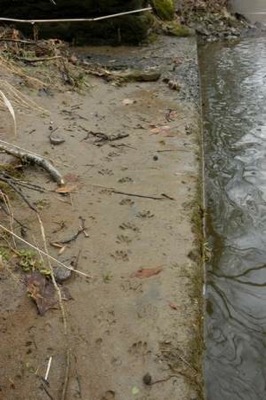
Native Delaware: Spring
Early signs of spring are popping up in Delaware
1:23 p.m., Feb. 27, 2013--Spring has sprung – or, if you’re an optimist like Dot Abbott it has.
“The skunk cabbage is popping up and will leaf out soon. Groundhogs and skunks are active again. And the spring peepers will be calling any day now,” says Abbott, a renewable resources agent for University of Delaware Cooperative Extension.
Campus Stories
From graduates, faculty
Doctoral hooding
Spring doesn’t officially arrive until March 20, but early signs of the season are evident – that is, if you’ve been outside and observant enough to notice.
If you haven’t spent time outside recently, get out there now, and take the kids with you, says Abbott.
“Today’s kids spend twice as much time indoors as their parents did,” notes Abbott, a board member of the Delaware Association for Environmental Education. “It’s important to be exposed to nature education at school but it’s even better to experience nature with your parents or other caregivers.”
Although the earth appears to be in winter slumber, it’s teeming with life and activity. Abbott suggests these ways to get the kids outside to spot the earliest signs of spring:
Track animals
Do your kids love mud? Then they’ll love looking for animal tracks. Tracks are easiest to find in mud (as well as snow). Throughout the winter, you can see tracks from white-tailed deer, fox, squirrels, muskrats and beavers – all of which are active year-round.
Now, as spring draws near, you can spot groundhog and skunk tracks, too. Delaware has few true hibernators but in winter groundhogs, skunks and some other mammals exist in a semi-hibernation state known as torpor.
Lately, the groundhogs and skunks have been out and about, especially on days when temperatures climbed above the mid-40s. A groundhog track is pretty easy to identify. Look for imprints with four toes on the front paws and five toes on the back. They will be spaced 4-12 inches apart.
Skunk tracks show five toes on both the front and back foot. The front tracks usually show claw marks farther ahead of the toe marks than the rear prints do. These longer front claws help the skunk dig up roots and insects.
Search for stream critters
Macro invertebrates are a good indicator of a stream’s health. They’re also a great way to see if spring has sprung.
Head to a pond or stream and take a close look at the water, says Abbott. The nymphs of dragonflies, mayflies and stoneflies are active all winter, often living beneath the ice. They feed and grow throughout the cold weather months to emerge as adults in early spring. If you have a smart phone, pull up photos of the adult form of these insects and see if your kids can spot any new adults in the water.
Increase your chances of seeing this transformation by scooping up a bucketful of nymphs and creek water. Place the bucket in a sunny but cool room of your house. If you’re lucky, you may get to witness some nymphs metamorphosize into adults.
Take a night hike
As winter heads into spring, the woods become noisier at night. Owl breeding season is underway, and with it, a cacophony of calls.
“Great horned owls started defending their territory and looking for mates at the end of January. They were the first calls I heard. Next, came the barred and barn owls. The last few nights, I’ve also heard screech owls,” says Abbott.
“Yet in between the owl calls, it can become so quiet that you can hear every leaf that crackles underfoot,” she notes.
It’s this combination of silence punctuated by mysterious sounds that makes Abbott love a night hike this time of year. Owls are just the start. Abbott often hears red foxes. These voluble creatures produce a variety of barks, howls and whines. Some are sharp yaps; others are long, mournful howls.
Spot the first robin of spring (or not)
Have you seen a robin? It feels more like spring, doesn’t it?
We hate to burst your bubble but robins stick around all year. Formerly a migratory bird, large numbers of robins now over-winter in Delaware. Abbott first noticed this phenomenon in the early to mid-1990s, though she’s quick to note that she’s not an expert on the subject.
Robins have been able adapt to Delaware winters. They switch from their summer diet of insects to eating seed in wintertime. Because they are fairly large birds, they’re usually able to withstand cold snaps.
Not every bird adapts so easily. For example, a homeowner called Abbott last month to report dead goldfinches in her backyard. Goldfinches normally migrate south but a half-dozen or so stragglers hung out in this Dover backyard during the fall and into winter. Unfortunately, when bitter cold weather hit, they weren’t able to survive.
Now that spring is drawing near, the robins have changed up their behavior. The early pollinators like skunk cabbage have appeared, and with them, insects. Robins can now be found feeding on invertebrates in grassy and disturbed areas.
Abbott enjoys birding at Wyoming Mill Pond. Other good birding spots include the St. Jones River, Mispillon River, and the many millponds found in Kent and Sussex counties. Be on the look out for resident robins, as well as some of the earliest returning migrants, says Abbott.
Article by Margo McDonough
Photo by Danielle Quigley








